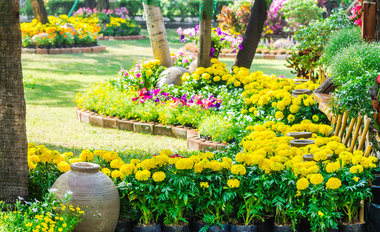
#1: Plant Shading Trees and Plants on the West
During the summer, the sun remains high and in the sky a lot longer than it does in winter. No matter where you are, the sun is going to set in the west.
That's why you should plant your garden on the west side of your home so the sun isn't beaming down on your garden at the hottest point during the day. Also, you could plant certain types of trees and vining plants to protect your more sensitive flowers from the summer heat. Try sunflowers, perennials and Asiatic lilies.
#2: Choose Plants and Flowers That Like the Heat
One of the easiest ways to protect your garden through the summer heat is to add plants and flowers that thrive in the heat. Some examples of beautiful and colorful flowers that withstand a lot of heat include:
- Salvias, which tolerate extreme heat and extreme cold.
- Coreopsis flowers, which are bright yellow and need very little water to thrive.
- Coneflowers that come in a rainbow of colors and can grow up to three feet.
- Rudbeckia, also known as "black-eyed Susan" perennials, which are drought-resistant and grow 48 inches high. Plus, you can cut them and stick them in a vase inside the house; they last longer than most cut flowers.
#3: Water Your Plants in the Early Morning
Finally, you want to be careful about how you water your plants. There are several things you may not know that will help keep your plants from drying out this summer. The first rule is to water your plants early in the morning. If you water your plants at night, chances are you'll get some of the leaves wet. Overnight, that water can turn into mildew and disease.
Once the sun rises, the heat is going to burn off the water too fast for your plants to absorb it. In the morning, they will have a better chance of absorbing water. Second, just because it rains, it does not mean that your plants have had enough water.
You can measure by leaving a tuna can outside in the rain. One can equals an inch of rain. Your plants need a third of that every few days to thrive. If your soil gets too dry, it could become resistant to water and will need more water than usual.
No comments:
Post a Comment